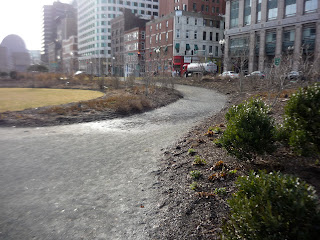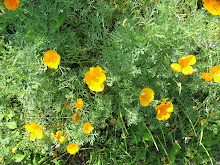As you can see, I have been a bit of a slacker when it comes to updating the blog. The main reason for this has been a fortunate one--I have been moving forward in my fledgling career as a freelance writer. After spending a good chunk of my day facing a screen, on those projects and commitments as well as my fiction, it has been difficult to bring myself to do
even more writing. Another reason is common among many garden bloggers: this is still the off-season. One can't simply upload a few photos and say, "Look, my organic Canton Dwarf bok choy is germinating!" Some folks can garden all year round; I don't seem to be one of them (see #7 below). Engaging topics can be as scarce as available plots in the Minton Stable Garden (the waiting list is now up to 40).
So I have decided to employ a strategy to help break my writer's block: lists. Make a list of something, anything, and maybe an idea will come from it. For example, in the northeast this is the time of year for waiting. Many gardeners are waiting for their seeds to arrive. Mine did yesterday, but now I have to wait for the right time to plant them. Here are some other things I'm waiting for, not necessarily impatiently, but waiting nonetheless.
1. Spring, obviously. Unlike the rest of the country and even other parts of Massachusetts we are just having a dull, wet winter. The rain has washed away the snow from this untouched garden path I photographed earlier this month.
 2.
2. The Minton Stable Community Garden
annual meeting, which will take place on March 29. Looking forward to catching up with some members I haven't seen since the fall, though a little nervous about co-running a large gathering. Right now I'm committed to giving a treasurer's report and collecting and recording many dues checks in a short period. And then there are the other questions: will we get through the agenda on time? What will spark controversy? Could be...
3...an anticipated proposal to
keep bees in the community garden. One of the gardeners along with an experienced bee keeper would like to establish a few hives on the property. The Steering Committee likes the idea and there are already a handful of interested volunteers, but the membership must approve it, a plan to fund it needs to be in place, and there has to be an agreement on its location. Stay tuned...
4. What will happen with the Rose Kennedy
Greenway Gardens. I had learned back in January that the Greenway Conservancy, which has been granted control over the development of the parcels where the gardens are located, was considering removing them. Now, it seems that the Conservancy wants some gardens as well, but has
reported on issues related to poor drainage and other problems with the existing gardens (which had been planted two years ago by volunteer master gardeners), and is trying to justify making significant changes that include building a pavilion.
Save the Greenway Gardens and others are keeping an eye on these developments; for their reaction to the Conservancy's findings and information about upcoming community meetings check out their
site.
5. Boston Natural Areas Network's
Gardener's Gathering, which will take place March 20 at Northeastern University. Workshops, prizes, other freebies, and an opportunity to fill the room when the Mayor makes his annual appearance (so green spaces and community gardens stay on his radar).
6. My Olympia spinach and State Fair Mix zinnia seeds, on backorder from
Fedco. I'm not too concerned about the zinnias but the spinach needs to be sown in late March.
7. My indoor herbs to thrive. Right now I'm down to one spindly coriander and and four starter pots of stunted basil seedlings. I think I can keep the basil but I'm not sure whether I should transplant them, change the distance of the grow lights, add fertilizer, or just move them to a sunny window.
8. The next installment of Daphne's
Get Growing series. She and another blogger have been publishing these thorough how-to posts that cover basics from seed starting to composting. The series has been informative; I'm not sure if Daphne and Robin get paid for writing the posts but they should. They appear the first of each month, so I won't have to wait long for the next one.
This list-making won't prevent me from becoming a weekly (or even monthly) blogger, but the exercise has been useful for generating or reminding myself of some topics for future posts.
 Lunch was calling, so before I left, I thinned out the Summertime Iceberg and Forellenschluss Romaine lettuces. To understand why they need to be grown in the sun, one needs only to compare this harvest (above) to the thinner, wimpier leaves picked earlier this evening (below) from the shady backyard garden my daughter and I planted. The MSG crops seem to have more bones to them, and if we continue to enjoy daytime temperature ranges in the 50s-70s, I'll be posting photos of full, crunchy heads by the beginning of June. If you want to compare these lettuces to others across the country and beyond, visit the Harvest Monday posts listed at Daphne's Dandelions.
Lunch was calling, so before I left, I thinned out the Summertime Iceberg and Forellenschluss Romaine lettuces. To understand why they need to be grown in the sun, one needs only to compare this harvest (above) to the thinner, wimpier leaves picked earlier this evening (below) from the shady backyard garden my daughter and I planted. The MSG crops seem to have more bones to them, and if we continue to enjoy daytime temperature ranges in the 50s-70s, I'll be posting photos of full, crunchy heads by the beginning of June. If you want to compare these lettuces to others across the country and beyond, visit the Harvest Monday posts listed at Daphne's Dandelions. But I don't want to jinx the situation. Anything can go wrong; today I encountered a familiar-looking scourge on my Tyee spinach. Already. I'm beginning to wonder that the only way to avoid leaf miners is to grow spinach in the fall.
But I don't want to jinx the situation. Anything can go wrong; today I encountered a familiar-looking scourge on my Tyee spinach. Already. I'm beginning to wonder that the only way to avoid leaf miners is to grow spinach in the fall. At home, I've been hardening off my tomato and brassica seedlings. Last week I transplanted my Black Prince and Rose de Berne tomatoes into larger containers and practiced more vigilance in giving them some time on the sunny front porch, and my efforts are paying off. They are catching up to where they probably should be at this time, and I may be able to plant them out this weekend.
At home, I've been hardening off my tomato and brassica seedlings. Last week I transplanted my Black Prince and Rose de Berne tomatoes into larger containers and practiced more vigilance in giving them some time on the sunny front porch, and my efforts are paying off. They are catching up to where they probably should be at this time, and I may be able to plant them out this weekend. I can't seem to achieve the same momentum for my broccoli and cauliflower. One year ago today, my Fiesta organic broccoli was not only twice the size as this year's, but already in the ground. This year, I'll be lucky if I can plant out all six of these: two Charming Snow cauliflower, three Fiesta organic broccoli, and the most advanced, the Piricicaba broccoli. I had started four times as many seeds; if I had had more time I would have moved more into larger pots, but I doubt the results would have been different. Now I'm wondering if I can still plant them out this weekend or if I need to wait for them to fatten up a little more. That, along with the arrival of the community garden compost delivery from BNAN and the purchase of a new camera (I've narrowed it down to a particular Canon model) will hopefully happen soon.
I can't seem to achieve the same momentum for my broccoli and cauliflower. One year ago today, my Fiesta organic broccoli was not only twice the size as this year's, but already in the ground. This year, I'll be lucky if I can plant out all six of these: two Charming Snow cauliflower, three Fiesta organic broccoli, and the most advanced, the Piricicaba broccoli. I had started four times as many seeds; if I had had more time I would have moved more into larger pots, but I doubt the results would have been different. Now I'm wondering if I can still plant them out this weekend or if I need to wait for them to fatten up a little more. That, along with the arrival of the community garden compost delivery from BNAN and the purchase of a new camera (I've narrowed it down to a particular Canon model) will hopefully happen soon.


























